 Toyota Yaris: If you have a flat tire
Toyota Yaris: If you have a flat tire
Remove the flat tire and replace it with the spare tire provided.
■ Before jacking up the vehicle
● Stop the vehicle on a hard, flat surface.
● Set the parking brake.
● Shift the shift lever to P (vehicles with an automatic transmission) or R (vehicles
with a manual transmission).
● Stop the engine.
● Turn on the emergency flashers.
■ Location of the spare tire, jack and tools

Taking out the jack

Move the driver seat to the front most position and remove the cover.

Take out the jack.
 For tightening
For tightening
 For loosening
For loosening
Taking out the spare tire

Lift the deck board and attach the hook. (→P. 217)
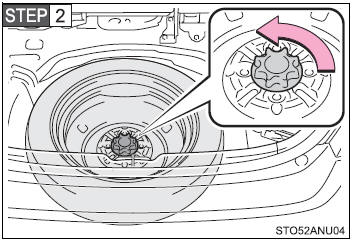
Loosen the center fastener that secures the spare tire.
Replacing a flat tire
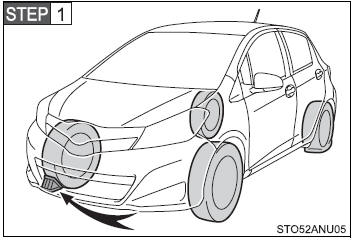
Chock the tires.
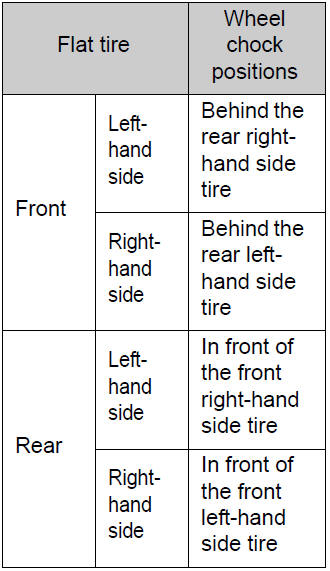
For vehicles with steel wheels, remove the wheel ornament using the wrench.
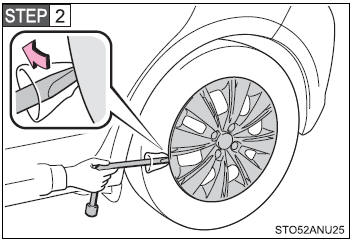
To protect the wheel ornament, place a rag between the wrench and the wheel ornament.

Slightly loosen the wheel nuts (one turn).
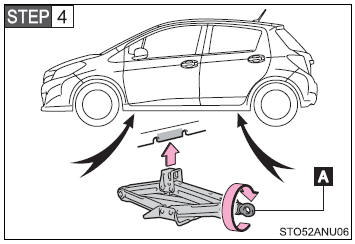
Turn the jack portion “A” by hand until the notch of the jack is in contact with the jack point.
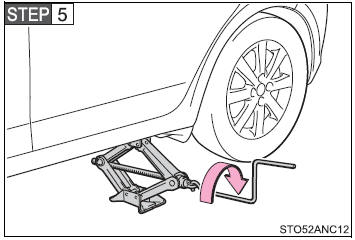
Raise the vehicle until the tire is slightly raised off the ground.
Remove all the wheel nuts and the tire.

When resting the tire on the ground, place the tire so that the wheel design faces up to avoid scratching the wheel surface.
Installing the tire
Remove any dirt or foreign matter from the wheel contact surface.
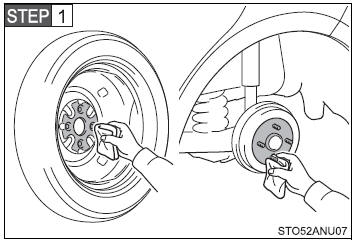
If foreign matter is on the wheel contact surface, the wheel nuts may loosen while the vehicle is in motion, causing the tire to come off.

Install the spare tire and loosely tighten each wheel nut by hand by approximately the same amount.

When replacing a steel wheel with a compact spare tire, tighten the wheel nuts until the tapered portion comes into loose contact with the disc wheel sheet.
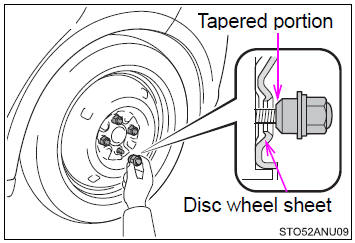
When replacing an aluminum wheel with a compact spare tire, tighten the wheel nuts until the tapered portion comes into loose contact with the disc wheel sheet.
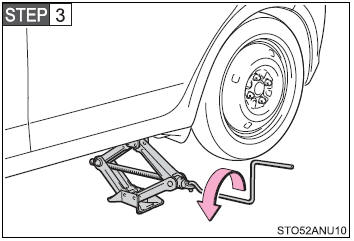
Lower the vehicle.
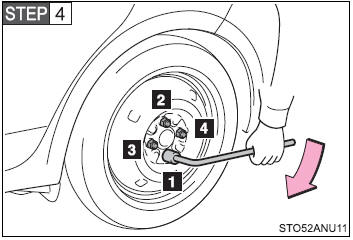
Firmly tighten each wheel nut two or three times in the order shown in the illustration.
Tightening torque:
76 ft·lbf (103 N·m, 10.5 kgf·m)
Stowing the flat tire, jack and all tools

Stow the jack and all tools.
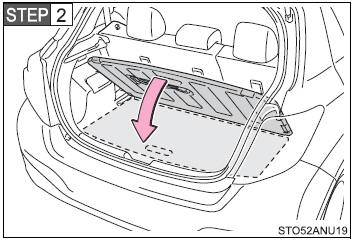
Return the deck board.
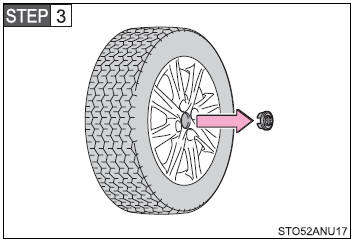
Vehicles with an aluminum wheels, remove the center wheel ornament by pushing from the reverse side.
Be careful not to lose the wheel ornament.

 Hook each belt end to the corresponding
anchor brackets.
Hook each belt end to the corresponding
anchor brackets.
 Put the center portion of the belt
onto the rear center head restraint.
Put the center portion of the belt
onto the rear center head restraint.

Lay the flat tire on the luggage floor so that the outer side of the tire wheel faces toward the rear of the vehicle. Detach the rear center head restraint from the seat and release the belt.

Pass the belt through the center hole of the flat tire wheel.
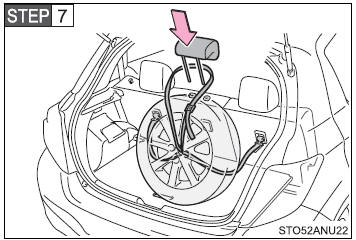
Put the center portion of the belt onto the rear center head restraint position and then return the rear center head restraint.

Hold the buckle and pull the belt to secure the tire.
After stowing the flat tire, check that the tire and belt are secured.
■The compact spare tire
●The compact spare tire is identified by the label “TEMPORARY USE ONLY” on the
tire sidewall.
Use the compact spare tire temporarily, and only in an emergency.
●Make sure to check the tire inflation pressure of the compact spare tire. (→P.
351)
■After completing the tire change (vehicles with a tire pressure warning system)
The tire pressure warning system must be reset. (→P. 255)
■When using the compact spare tire (vehicles with a tire pressure warning system)
As the compact spare tire is not equipped with a tire pressure warning valve and transmitter, low inflation pressure of the spare tire will not be indicated by the tire pressure warning system. Also, if you replace the compact spare tire after the tire pressure warning light comes on, the light remains on.
■If you have a flat front tire on a road covered with snow or ice
Install the compact spare tire on one of the rear wheels of the vehicle. Perform the following steps and fit tire chains to the front tires:

Replace a rear tire with the compact spare tire.

Replace the flat front tire with the tire removed from the rear of the vehicle.

Fit tire chains to the front tires.
CAUTION
■When using the compact spare tire
●Remember that the compact spare tire provided is specifically designed for use
with your vehicle. Do not use your compact spare tire on another vehicle.
●Do not use more than one compact spare tire simultaneously.
●Replace the compact spare tire with a standard tire as soon as possible.
●Avoid sudden acceleration, deceleration and braking, as well as sharp cornering.
■When storing the compact spare tire
Be careful not to catch fingers or other body parts between the compact spare tire and the body of the vehicle.
■When the compact spare tire is attached
The vehicle speed may not be correctly detected, and the following systems may not operate correctly:
●ABS
●Brake assist
●VSC
●TRAC
●Cruise control (if equipped)
CAUTION
■Speed limit when using the compact spare tire
Do not drive at speeds in excess of 50 mph (80 km/h) when a compact spare tire is installed on the vehicle. The compact spare tire is not designed for driving at high speeds. Failure to observe this precaution may lead to an accident causing death or serious injury.
■Using the tire jack
Improper use of the tire jack may cause the vehicle to suddenly fall off the jack, leading to death or serious injury.
●Do not use the tire jack for any purpose other than replacing tires or installing
and removing tire chains.
●Only use the tire jack that comes with this vehicle for replacing a flat tire.
Do not use it on other vehicles, and do not use other jacks for replacing tires
on this vehicle.
●Always check that the tire jack is securely set to the jack point.
●Do not put any part of your body under the vehicle while it is supported by the
jack.
●Do not start or run the engine while your vehicle is supported by the jack.
●Do not raise the vehicle while someone is inside.
●When raising the vehicle, do not put an object on or under the jack.
●Do not raise the vehicle to a height greater than that required to replace the
tire.
●Use a jack stand if it is necessary to get under the vehicle.
Take particular care when lowering the vehicle to ensure that no one working on or near the vehicle may be injured.
CAUTION
■Replacing a flat tire
●Do not touch the disc wheels or the area around the brakes immediately after
the vehicle has been driven. After the vehicle has been driven the disc wheels and
the area around the brakes will be extremely hot. Touching these areas with hands,
feet or other body parts while changing a tire, etc. may result in burns.
●Failure to follow these precautions could cause the wheel nuts to loosen and the
tire to fall off, resulting in death or serious injury.
• Have the wheel nuts tightened with a torque wrench to 76 ft·lbf (103 N·m, 10.5
kgf·m) as soon as possible after changing wheels.
• When installing a tire, only use wheel nuts that have been specifically designed
for that wheel.
• If there are any cracks or deformations in the bolt screws, nut threads or bolt
holes of the wheel, have the vehicle inspected by your Toyota dealer.
• When installing the wheel nuts, be sure to install them with the tapered ends
facing inward. (→P. 267)
■When stowing the flat tire
●Make sure the rear seats are in their original position.
●Secure it using a tire tie-down belt. Otherwise, the flat tire may fly out in case
of the sudden braking or an accident, resulting in death or serious injury.
NOTICE
■Do not drive the vehicle with a flat tire
Do not continue driving with a flat tire. Driving even a short distance with a flat tire can damage the tire and the wheel beyond repair.
■Be careful when driving over bumps with the compact spare tire installed on the vehicle
The vehicle becomes lower when driving with the compact spare tire compared to when driving with standard tires. Be careful when driving over uneven road surfaces.
■Driving with tire chains and the compact spare tire
Do not fit tire chains to the compact spare tire. Tire chains may damage the vehicle body and adversely affect driving performance.
■When replacing the tires (vehicles with a tire pressure warning system)
When removing or fitting the wheels, tires or the tire pressure warning valve and transmitter, contact your Toyota dealer as the tire pressure warning valve and transmitter may be damaged if not handled correctly.
■To avoid damage to the tire pressure warning valves and transmitters (vehicles with a tire pressure warning system)
When a tire is repaired with liquid sealants, the tire pressure warning valve and transmitter may not operate properly. If a liquid sealant is used, contact your Toyota dealer or other qualified service shop as soon as possible. Make sure to replace the tire pressure warning valve and transmitter when replacing the tire. (→P. 255)
 If a warning light turns on or a warning buzzer sounds...
If a warning light turns on or a warning buzzer sounds...
Calmly perform the following actions if any of the warning lights comes on
or flashes. If a light comes on or flashes, but then goes off, this does not necessarily
indicate a malfunction in the sy ...
 If the engine will not start
If the engine will not start
If the engine will not start even though correct starting procedures are being
followed (→P. 124), consider each of the following points:
■ The engine will not start even though the sta ...
See also:
Cowl top side upper panel (ASSY)
REPLACEMENT
With the cowl top side panel removed.
INSTALLATION
Temporarily install the new parts and measure each part of the new parts in accordance
with the body dimension diagram. (See the ...
Rear window wiper and washer
The wiper operation is selected by moving the lever as follows:
Vehicles without intermittent rear wiper (Type A)
Normal window wiper operation
Washer/wiper dual operation
Washer operation ...
Electric power steering system
The electric power steering system, using an electric motor, assists the turning
of the steering wheel.
In the following cases, you may feel the steering becomes heavy. But it is not
a malfunctio ...
